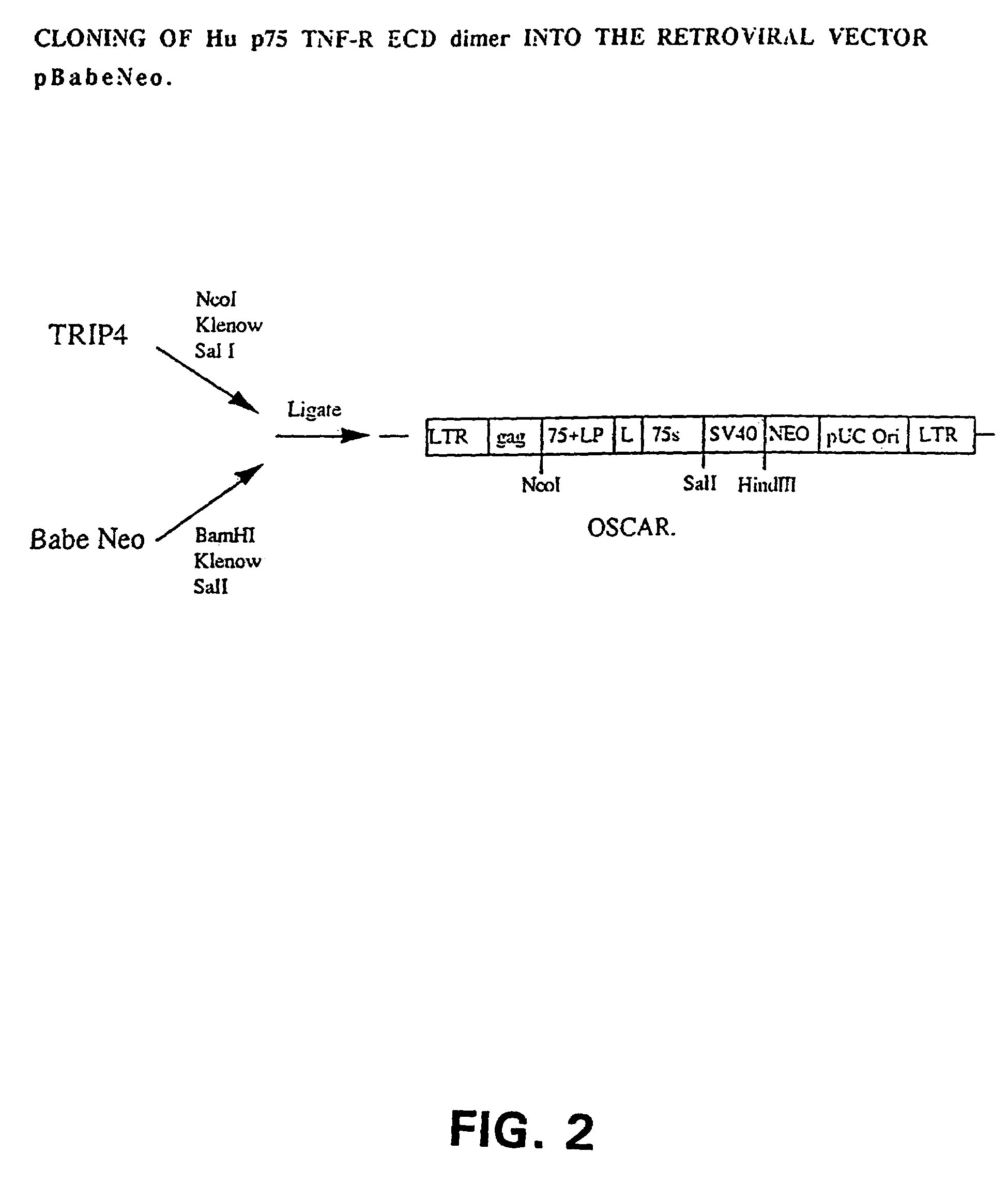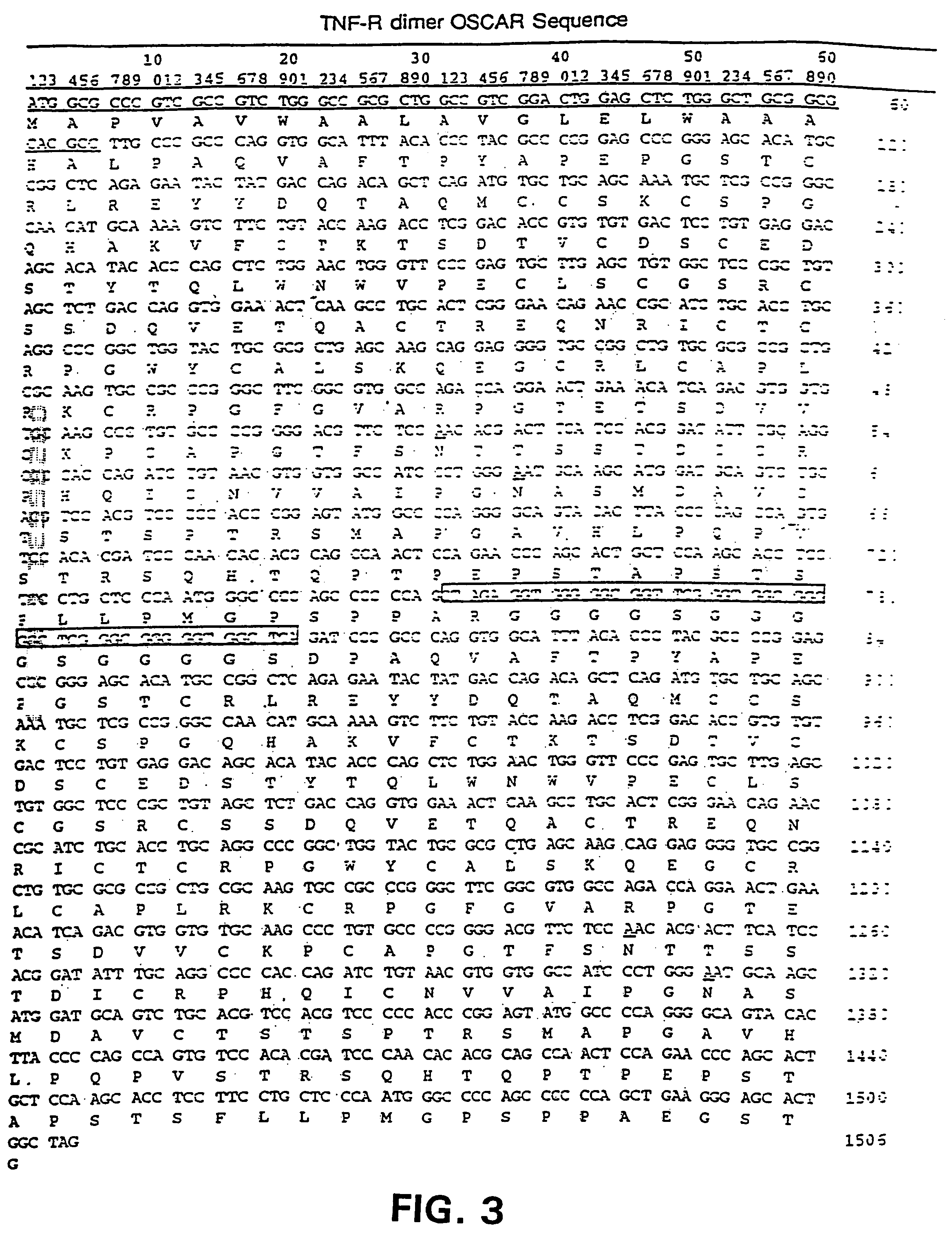Small molecular weight TNF receptor multimeric molecule
- Summary
- Abstract
- Description
- Claims
- Application Information
AI Technical Summary
Benefits of technology
Problems solved by technology
Method used
Image
Examples
example 1
Cloning of the Hu p75 TNF-R ECD Dimer
[0043]In order to express a small molecular weight Hu p75 TNF-R ECD dimer, we constructed the retroviral expression vector, Oscar, that was built in a multiple-step cloning procedure described below. Plasmids were grown using DH5α competent cells [supE44 DlacU169 f80 lacZDM15) hsdR17 recA1 endA1 gyrA96 thi-1 relA1].
PCR of Human p75 TNF-R Extracellular Domain
[0044]The Hu p75 TNF-R ECD was amplified by PCR from the pVL1393-Hu p75 TNF-R ECD plasmid using primers (1) and (2) shown below. pVL1393-Hu p75 TNF-R ECD (derived from pVL1393, In-Vitrogen) contained the Hu p75 TNF-R ECD from amino acid 1 to 205 with a 3′ stop codon. The 5′ primer (1) contained a BamHI restriction site. Bases 7 to 30 of primer (1) annealed to bases 70 to 93 of the mature Hu p75 TNF-R ECD. The 3′ primer which anneals to the multiple cloning site of the pVL1393, downstream of the ECD insert, contained an Asp718 restriction site.[0045](1) 5′ TCGGATCCCGCCCAGGTGGCATTTACACCC 3′(SEQ ...
example 2
Transfection of GPenvAM12 Cells with the Dimeric Hu p75 TNR-R ECD Retroviral Vector
[0057]Permanent transfections were done in GPenvAM12 cells (Markowitz, D., et al., Virology, 167:400 (1988)). Stable transfectants expressing the Hu p75 TNF-R ECD dimer were made in the cell line GPenvAm12 and G418 was used to select for permanent transfectants. These cells constitutively express the protein which is secreted into the media.
[0058]The GPenv AM12 cells were grown and maintained in DMEM medium supplemented with 10% new-born calf serum, 2.5 units / ml penicillin, 2.5 μg / ml streptomycin and 2 mM glutamine.
[0059]For stable expression of Oscar from GPenvAM12 cells (Markowitz, D., et al., Virology, 167:400 (1988)), 20 μg of vector DNA were transfected into the cell line using the calcium-phosphate precipitation method. Transfected cells were selected and maintained in medium with 1 mg / ml G418. G418 resistant cell clones were pooled and tested for expression of Hu p75 TNF-R ECD dimer by ELISA, W...
example 3
Protection from TNF Cytotoxicity on WEHI Cells by Hu p75 TNF-R ECD Construct
[0067]WEHI Assay. The concentrated supernatants were tested for protection against TNF cytotoxicity in the WEHI cell assay. To measure the inhibitory effect of the expressed Hu p75 TNF-R ECD dimer on TNF cytotoxic activity, WHEI 164 clone 13 mouse fibrosarcoma cells were used (Espevic, T., and Nissen-Meyer, J., J. Immunol. Methods, 95:99 (1986)).
[0068]FIG. 5 shows the protective effect obtained in this assay when TNF was preincubated with dilutions of various Hu p75 TNF-R ECD proteins. However, the two dimeric Hu p75 TNF-R ECD constructs namely p75 sf2 and Oscar efficiently protected WEHI cells from TNF cytotoxicity. Table 1 shows that 20 pg dimeric Hu TNF-R75 ECD were sufficient to inhibit by 50% the killing activity of 63.5 pg of human TNF. In comparison, 57 pg of the dimeric Hu p75 TNF-R ECD in an Ig backbone (p75 sf2) (Butler, D., et al., Cytokine, 6:616 (1994)) were needed to obtain the same level of pr...
PUM
| Property | Measurement | Unit |
|---|---|---|
| Ratio | aaaaa | aaaaa |
| Biological properties | aaaaa | aaaaa |
| Nucleic acid sequence | aaaaa | aaaaa |
Abstract
Description
Claims
Application Information
 Login to View More
Login to View More - R&D
- Intellectual Property
- Life Sciences
- Materials
- Tech Scout
- Unparalleled Data Quality
- Higher Quality Content
- 60% Fewer Hallucinations
Browse by: Latest US Patents, China's latest patents, Technical Efficacy Thesaurus, Application Domain, Technology Topic, Popular Technical Reports.
© 2025 PatSnap. All rights reserved.Legal|Privacy policy|Modern Slavery Act Transparency Statement|Sitemap|About US| Contact US: help@patsnap.com



